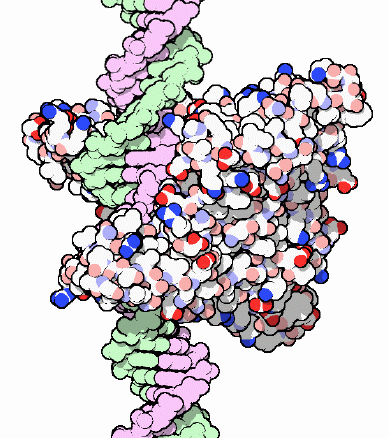|
Inhaltsübersicht | Nanomaschinen | Moleküle | Programme | Kurse | Fun | Links |
||
| > |
Restriction Enzymes

Bacteria Fight Back
Bacteria are under constant attack by bacteriophages, like the bacteriophage phiX174 described in an earlier Molecule of the Month. To protect themselves, many types of bacteria have developed a method to chop up any foreign DNA, such as that of an attacking phage. These bacteria build an endonuclease--an enzyme that cuts DNA--which is allowed to circulate in the bacterial cytoplasm, waiting for phage DNA. The endonucleases are termed "restriction enzymes" because they restrict the infection of bacteriophages.
Molecular Scissors
Each type of restriction enzyme seeks out a single DNA sequence and precisely cuts it in one place. For instance, the enzyme shown here, EcoRI, cuts the sequence GAATTC, cutting between the G and the A. Of course, roving endonucleases can be dangerous, so bacteria protect their own DNA by modifying it with methyl groups. These groups are added to adenine or cytosine bases (depending on the particular type of bacteria) in the major groove. The methyl groups block the binding of restriction enzymes, but they do not block the normal reading and replication of the genomic information stored in the DNA. DNA from an attacking bacteriophage will not have these protective methyl groups and will be destroyed. Each particular type of bacteria has a restriction enzyme (or several different ones) that cuts a specific DNA sequence, paired with a methyl-transferase enzyme that protects this same sequence in the bacterial genome.
Next: Sticky Ends
Last changed by: A.Honegger,